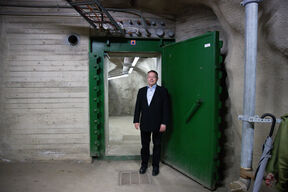Doctoral thesis: Finland’s civil defence shelters protect nearly everyone – but hotter summers may test their limits

Finland has around 50,500 civil defence shelters that provide protection to almost our entire population from conventional warfare as well as nuclear, biological, and chemical threats. A recent doctoral thesis from Aalto University reveals that Finland’s civil defence system is internationally both exceptionally cost-effective and comprehensive.
“The most significant feature of the Finnish civil defence system is its funding model: the construction costs of the shelters are borne by their owners – primarily private property owners – not taxpayers,” explains Pekka Kyrenius, Licentiate of Technology, who will defend his dissertation on June 17.
Kyrenius's dissertation in the field of mechanical engineering discusses the development of regulations and technical specification concerning civil defence shelters in Finland from 1954 to 2011.
“Over decades, through broad collaboration, a high-quality civil defence shelter system has been built in Finland, with the total infrastructure cost estimated at about 4.4 billion euros. This sum corresponds, on average, to about three years of defence budget at the time of evaluation. The development of the system can indeed be considered a rare success story,” says Kyrenius.
The research also compares Finland's progress internationally.
“Our civil defence system has the most comprehensive coverage among the Nordic countries, offering slightly cramped and uncomfortable, yet adequate and functional protection from weapons effects to almost the entire population in an actual crisis.”
However, there are areas for improvement.
“In cramped shelters, the occupants themselves are a significant source of heat. Since cooling relies on ventilation without electrically operated air conditioning, managing temperature could be challenging due to increasingly hot summers. More research is needed on potential air conditioning needs and temperature management,” Kyrenius notes.
Current threat models developed by authorities anticipate sheltering periods to be frequent but short-term.
“During possible long-term sheltering periods, temperatures in some shelters may rise to dangerous levels, especially for the most vulnerable groups, such as the elderly,” Kyrenius says.
During the period examined, the evolution of civil defence shelters in Finland was influenced by the Finnish wartime experiences, demands for cost-effectiveness, Finland’s role as a neutral country, and international influences. The aim has been both to protect the population cost-effectively during potential wars and to provide a reasonably safe and healthy environment during sheltering.
The current Rescue Act, the Civil Defence Shelter Decrees and the regulations came into force in 2011. Now, the Rescue Act and the Civil Defence Shelter Decrees are set to be revised. The work on revising the civil defence shelter regulations is expected to begin in 2026.
More information:
Public defence in Mechanical Engineering, Lic.Sc.(Tech.) Pekka Kyrenius
The Finnish Civil Defence Shelter System - Evolution of the regulation and technical specification 1954-2011 (title of the thesis).

Read more news

Unite! Seed Fund 2026: Call opens on 20 January 2026
Gain an early overview of the Unite! Seed Fund Call of Spring 2026. The call includes three funding lines: Student Activities, Teaching and Learning, and Research and PhD.
Deepika Yadav leverages technology to improve women's health
Deepika Yadav recently began as an assistant professor at the Department of Computer Science in the field of human-computer interaction (HCI) and interaction design for health and wellbeing.
Study: Internal combustion engine can achieve zero-emission combustion and double efficiency
A new combustion concept that utilizes argon could completely eliminate nitrogen oxide emissions from internal combustion engines and double their efficiency compared to diesel engines.






